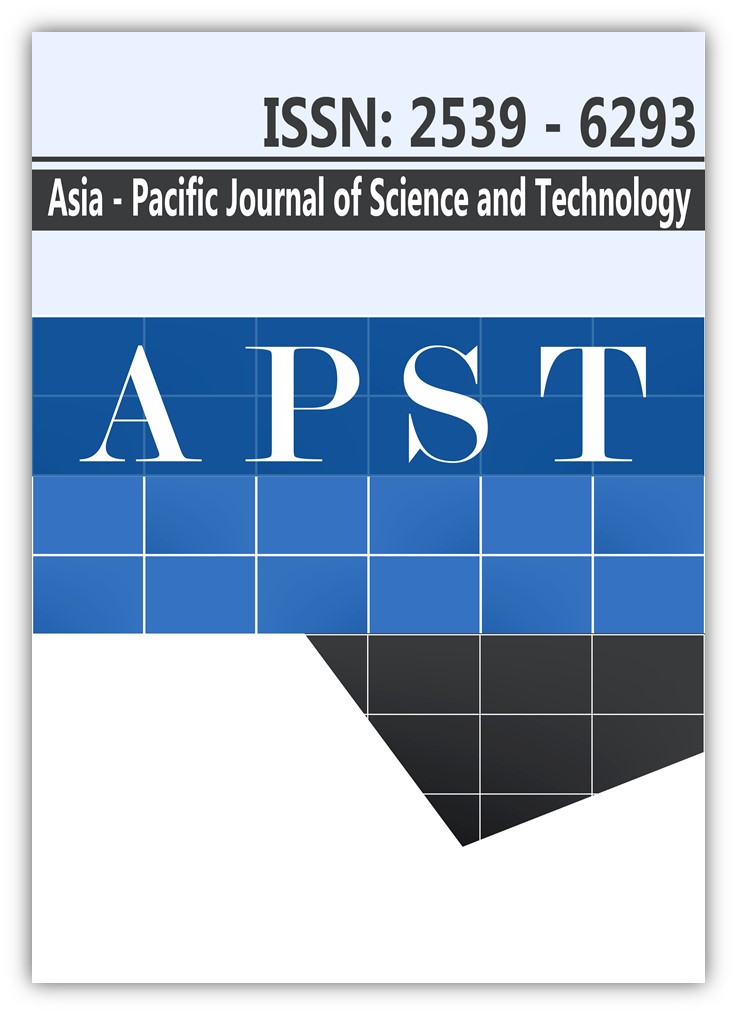Molecular typing of crude-oil-degrading bacterial strains from Riau, Indonesia
Main Article Content
Abstract
Petroleum contamination is a global concern in microbial enhanced oil recovery (MEOR) procedure, including in Riau, Indonesia, being one of the provinces with petroleum activities. These contaminants could be removed through bioremediation using crude-oil-degrading microorganisms or hence called hydrocarbonoclastic bacteria, especially the well-adapted indigenous bacterial strains from the contaminated sites. In this study, three indigenous isolates, Bacillus cereus IMB-11, Lysinibacillus fusiformis IMB-12, and Pseudomonas stutzerii IMB-15, were successfully recovered and identified from a petroleum-containing site of Chevron Pacific Indonesia (CPI) Ltd., Petapahan, Riau, Indonesia. These hydrocarbonoclastic isolates were strain-typed based on 16S rDNA and the results showed that B. cereus IMB-11 was closely related to the USA strain, L. fusiformis IMB-12 was closely related to the China and Indian strains, while P. stutzeri IMB-15 was related to strains from Africa, Asia and Europe. Also, the bioremediation assay of petroleum in a 72-h incubation experiment resulted in the removal of total petroleum hydrocarbon(s) (TPH) and chemical oxygen demand (COD) reduction by these bacterial strains during fermentation in crude oil-supplemented media (10%, v/v). Results showed that the highest TPHs removal was achieved by both B. cereus IMB-11 and P. stutzeri IMB-15 at 76.64% while L. fusiformis IMB-12 was the lowest at 62.62%. In COD analysis, the initial concentration was 15 mg/mL, also with the control flask, however, the highest COD removal was achieved by B. cereus IMB-11 at 88.55%, followed by L. fusiformis IMB-12 at 82.01%, and then P. stutzeri IMB-15 at 42.05%. Based on these results, the hydrocarbonoclastic bacterial strains have the potential to be used as bioremediation agents.
Article Details
References
Das N, Chandran P. Microbial degradation of petroleum hydrocarbon contaminants: a review. Biotechnol Res Potential. 2011;2011:1-13.
Leahy JG, Colwell RR. Microbial degradation of hydrocarbons in the environment. Microbiol Rev. 1990;54:305-315.
Adipah S. Introduction of petroleum hydrocarbons contaminations and its human effects. J Environ Sci Public Health. 2018;3:1-9.
Brooijmans RJW, Pastink MI, Siezen RJ. Hydrocarbon-degrading bacteria: the oil-spill clean-up crew. Microb Biotechnol. 2009;2:587-594.
Dvoˇrák P, Nikel PI, Damborský J, de Lorenzo V. Bioremediation 3.0: engineering pollutant-removing bacteria in the times of systemic biology. Biotechnol Adv. 2017;35:845-866.
Albokari M, Mashhour I, Alshehri M, Boothman C, Al-Enezi M. Characterization of microbial communities in heavy crude oil from Saudi Arabia. Ann Microbiol. 2015;65:95-104.
Borah D, Agarwal K, Khataniar A, Konwar D, Gogol SB, Kallel M. A newly isolated strain of Serratia sp. from an oil spillage site of Assam shows excellent bioremediation potential. 3 Biotech. 2019;9:283.
Borah D, Yadav RNS. Molecular characterization of biosurfactant producing Bacillus cereus strain DRDU1 for its potential application in bioremediation and further EOR studies. Petrol Sci Technol. 2018; 36(19):1605-1612.
Borah D, Yadav RNS. Bioremediation of petroleum based contaminants with biosurfactant produced by a newly isolated petroleum oil degrading bacterial strain. Egypt J Pet. 2017;26:181-188.
Borah D, Yadav RNS. Biodegradation of petroleum oil by a novel Bacillus cereus strain DRDU1 from an automobile engine. Int J Environ Res. 2014;8:1287-1294.
Kumar S, Stecher G, Li M, Knyaz C, Tamura K. MEGA X: molecular evolutionary genetics analysis across computing platforms. Mol Biol Evol. 2018;35:1547-1549.
Edgar RC. MUSCLE: multiple sequence alignment with high accuracy and high throughput. Nucleic Acids Res. 2004;32:1792-797.
Felsenstein J. Confidence limits on phylogenies: an approach using the bootstrap. Evol. 1985;39:783-791.
Sayuti I, Siregar YI, Amin B, Agustien A, Djamaan A. Identification of bacterial hydrocarbonoclastic in waste tanks, Petapahan, Riau, Indonesia using 16S rDNA. J Pure Appl Microbiol. 2018;12:671-677.
Naowasam S, Leungprasert S. Abundance and diversity of hydrocarbon utilizing bacteria in the oil-contaminated soils throughout a remedial scheme using compost amendment. Songklanakarin J Sci Technol. 2019;41:12-20.
WEF, AWWA, APHA. Chemical oxygen demand (COD): Standard methods for the examination of water and wastewater [Internet]. Virginia: American Public Health Association, American Water Works Association, Water Environment Federation; 2018 [cited 2018 Aug 27]. Available from: https://www. standardmethods.org/doi/pdf/10.2105/SMWW.2882.103.
Spini G, Spina F, Poli A, Blieux A, Regnier T, Gramellini C, et al. Molecular and microbiological insights on the enrichment procedures for the isolation of petroleum degrading bacteria and fungi. Front Microbiol. 2018;9:1-19.
Koski LB, Golding GB. The closest BLAST hit is often not the nearest neighbor. J Mol Evol. 2001;52:540-542.
Janda JM, Abbott SL. 16S rDNA gene sequencing for bacterial identification in the diagnostic laboratory: pluses, perils, and pitfalls. J Clin Microbiol. 2007;45:2761-2764.
Maiden MC. Multilocus sequence typing of bacteria. Ann Rev Microbiol. 2006;60:561-588.
Li SW, Huang YX, Liu MY. Transcriptome profiling reveals the molecular process for survival of Lysinibacillus fusiformis strain 15-4 in petroleum environments. Ecotoxicol Environ Saf. 2020;192: 110250.
Celik GY, Aslim B, Beyatli Y. Enhanced crude oil biodegradation and rhamnolipid production by Pseudomonas stutzeri strain G11 in the presence of Tween-80 and Triton X-100. J Environ Biol. 2008;29:867-870.
Karlapudi AP, Venkateswarulu TC, Tammineedi J, Kanumuri L, Ravuru BK, Dirisala VR, et al. Role of biosurfactants in bioremediation of soil pollution-a review. Petroleum. 2018;4:241-249.
Peixoto RS, Vermelho AB, Rosado S. Petroleum-degrading enzymes: bioremediation and new prospects. Enzyme Res. 2011;2011:1-8.
Colwell RR, Walker JD, Cooney JJ. Ecological aspects of microbial degradation of petroleum in the marine environment. Crit Rev Microbiol. 1977;5:423-445.
Al-Wasify RS, Hamed SR. Bacterial degradation of crude oil using local isolates. Int J Bacteriol. 2014;2014:1-9.
Varma SS, Lakshmi MB, Velan M. Isolation and characterization of non-adapted BTEX degrading bacterial strains from petroleum contaminated environment. J Pure Appl Microbiol. 2015;9:3161-3169.
Syakti AD, Lestari P, Simanora S, Sari LK, Lestari F, Idris F, et al. Culturable hydrocarbonoclastic marine bacterial isolates from Indonesian seawater in the Lombok Strait and Indian Ocean. Heliyon. 2019;5:1-9.
Goveas LC, Krishna A, Salian A, Menezes J, Alva M, Basavapattan B, et al. Isolation and characterization of bacteria from refinery effluent for degradation of petroleum crude oil in seawater. J Pure Appl Microbiol. 2020;14(1):473-484.
Xu X, Liu W, Tian S, Wang W, Qi Q, Jiang P, et al Petroleum hydrocarbon-degrading bacteria for the remediation of oil pollution under aerobic conditions: a perspective analysis. Front Microbiol. 2018;9:1-11.


